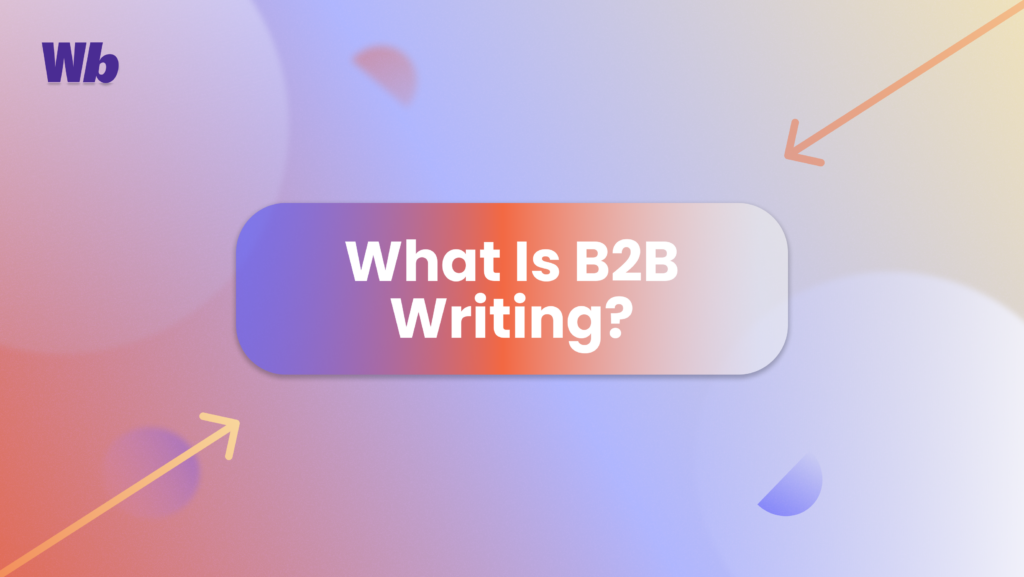Table of Contents
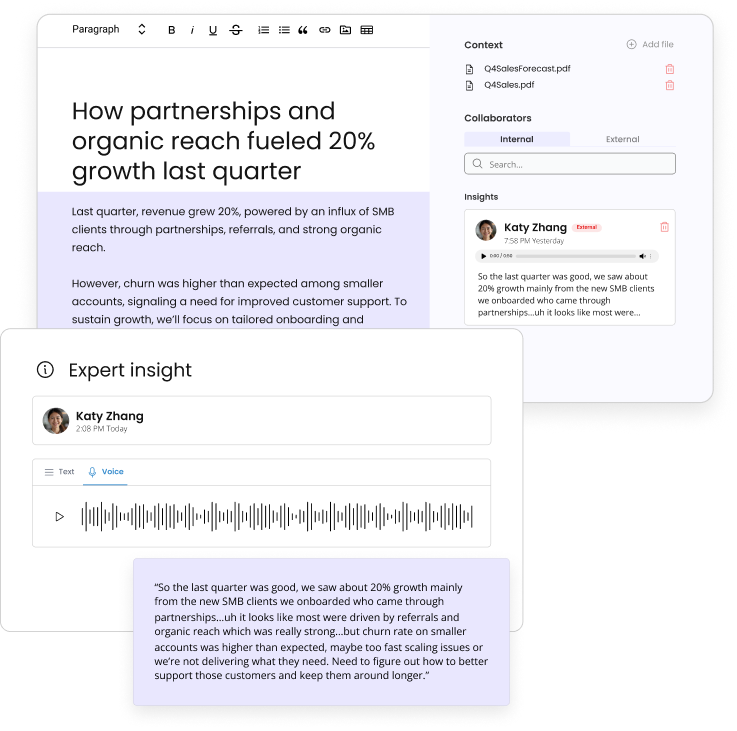
Authority scales when expertise comes first
Wordbrew helps teams collect expert insight before AI ever writes a word.
Built for expert-led, review-safe content
- Home
- »
- Content Marketing
- »
- What is B2B writing? Definition, examples, and guidelines
-
Anna Louise
- 12 minutes read time
What is B2B writing? Definition, examples, and guidelines
- Home
- »
- Content Marketing
- »
- What is B2B writing? Definition, examples, and guidelines
What is B2B writing? Definition, examples, and guidelines
Table of Contents
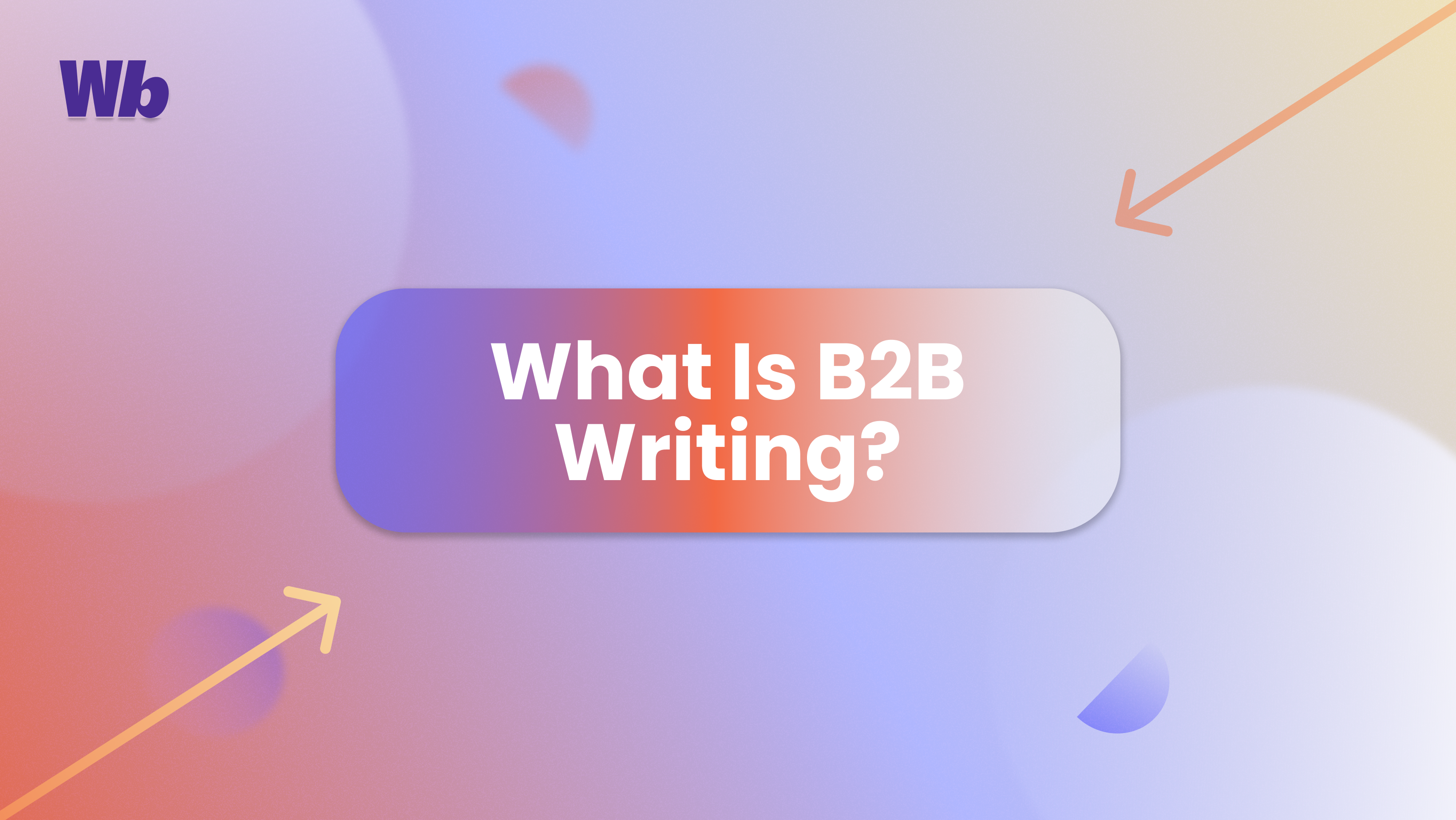
B2B writing is content crafted for businesses selling to other businesses. Think of it as a conversation between professionals seeking solutions and forming partnerships.
But what makes B2B writing distinct from its consumer-focused counterpart, B2C writing?
B2B writing addresses specific industry needs, often diving deep into topics that might seem complex. The challenge lies in breaking down this complexity: A skilled B2B writer should transform intricate details into digestible information.
B2C writing, on the other hand, speaks directly to the end consumer, aiming to connect on a personal and emotional level. This style of writing often prioritizes relatability, simplicity, and a touch of storytelling. A proficient B2C writer crafts messages that resonate with the everyday experiences and aspirations of the general public, turning products and services into must-haves.
In the following article, we’ll peel back the layers of B2B writing, offering valuable insights and guiding you through its nuances. Whether you’re looking to understand its basics or explore writing best practices, we’ve got you covered. Let’s get started.
What is B2B writing?
B2B writing is a specialized form of content crafted for businesses that sell to other businesses. At its core, B2B writing involves talking professional-to-professional and addressing challenges unique to specific industries.
In B2B writing, language choice distinguishes it from other writing styles. It’s crucial to employ industry knowledge and specific terms to demonstrate expertise and maintain accuracy. However, excessive use of jargon, particularly for those new to the field, can lead to confusion.
For example, let’s consider a business selling marketing attribution software. A potential customer might start their research with a simple query: “What is B2B marketing?”. Bombarding them with highly technical terms at this stage might push them away. They might think, “This isn’t for me,” and move on.
The structure of effective B2B content resembles a funnel. A reader starts at the entrance, often seeking basic information, and is gradually led deeper, exploring more detailed and specific content. Every piece has a place and purpose, serving the reader’s current level of knowledge and curiosity.
This journey, from initial interest to the final decision, is shaped by search intent and awareness levels. Consider your customer’s starting point and create content to meet them there. If they’re at the start, give them an introduction. If they’re further along, offer the depth they crave.
In essence, B2B writing is a synthesis between clarity and specificity. It’s about offering the right information at the right time and guiding without overwhelming.
What is the difference between B2B writing and B2C writing?
When crafting content, you need to know your audience and clients—and the differences between B2B and B2C audiences are like night and day. Let’s break down how writing for these two groups varies:
1. Audience consideration: Who’s listening?
B2B content is typically crafted for professionals who make decisions on behalf of their organizations. They have responsibility for the money and strategic planning for clients and are focused on long-term objectives.
In contrast, B2C content is directed at individual consumers, emphasizing their personal preferences and immediate needs.
B2B audience targeting:
- Role-specific: A CTO focuses on the technical aspects of software, while a CFO eyes its cost-effectiveness. For instance, the CTO looks at security when considering cloud storage, while the CFO evaluates cost savings.
- Team decision-making: Buying new equipment might need inputs from multiple departments, each with unique concerns.
- Long-term vision: Professionals play the long game. When assessing an ERP system, they consider its benefits over several years, not just the immediate future.
B2C audience targeting:
- Personal preferences: A college student might prioritize a laptop’s gaming capabilities, while a graphic designer values its screen quality.
- Quick decisions: B2C purchases, influenced by trends or ads, often happen rapidly, sometimes within hours.
- Emotionally driven: Purchasing decisions, like buying a luxury item, can be based on the associated prestige or emotional satisfaction beyond just utility.
In summary: B2B audiences prioritize in-depth analysis and long-term benefits, while B2C audiences lean toward personal relevance and immediate needs.

2. Subject depth: What’s the topic?
B2B topics tend to be specialized, catering to industry-specific needs. For instance, a B2B article might discuss the benefits of integrating AI into manufacturing to increase efficiency. Being seen as a leader in your field of expertise can yield tremendous benefits when it comes to building new relationships with great clients.
Conversely, B2C content is more overarching and relatable, like an article introducing the benefits and ease of use of a new smartphone’s camera features for everyday photography enthusiasts.
B2B content requires depth and precision tailored to industry needs. Fundamental B2B guidelines include:
- Offer detailed insights, like discussing the algorithms in AI-driven predictive maintenance.
- Propose solutions to industry problems, emphasizing cost reduction and efficiency.
- Validate claims using case studies or quantifiable results.
- Promote further engagement with resources, webinars, or contact points.
In contrast, B2C content should be accessible and engaging:
- Keep it straightforward. For instance, simply showcase a smartphone camera’s superior low-light performance.
- Connect emotionally, using real-life moments where products add value.
- Incorporate visuals, like a photo comparison, to highlight a camera’s edge.
- Use direct calls to action, like “Buy Now,” to spur immediate interest.
In summary: Tailoring content depth to your audience’s expectations and needs is crucial. B2B content should aim for expertise and solution-driven depth, while B2C content should be clear, engaging, and action-oriented.
3. Decision dynamics: Who decides?
In the B2B sector, decision-making often involves multiple stakeholders. A proposal might undergo several rounds of reviews and revisions before getting approved. All decisions must also be held under the lens of new, existing, and potential customers.
B2C decisions, on the other hand, are usually made by individual consumers based on personal preferences and can be made relatively quickly.
B2B decision dynamics: A company is considering a new fleet management software. The IT manager begins the process, and logistics, finance, and upper management soon join in. Multiple presentations, trials, and weeks of discussions later, a decision is made.
B2C decision dynamics: Jane seeks a new pair of running shoes online. She reviews a few options, checks user feedback, and, within an hour, makes a purchase based on her preferences.
Analysis: B2B decisions at companies involve numerous stakeholders and extended deliberations. Jane’s B2C decision is swift and individualistic.
Content tailored to different decision dynamics recognizes the complexity and speed of the decision-making processes in B2B and B2C contexts. Here’s how they differ:
B2B content:
- Depth: Provides comprehensive details like product specs, case studies, and ROI.
- Tone: Formal, targeting experts and organizational decision-makers.
- Engagement: Calls to action may prompt a demo, consultation, or white paper download.
- Support: Offers further resources and contacts due to longer decision-making.
B2C content:
- Brevity: Concise, emphasizing the main benefits or features.
- Tone: Casual, aligning with personal emotions and needs.
- Engagement: Direct calls to action like “Buy Now” or “Add to Cart.”
- Visuals: Uses striking visuals, slogans, or influencer endorsements to prompt quick decisions.
In summary: B2B content is thorough, professional, and resourceful, reflecting business’ collaborative and prolonged decision dynamics. B2C content is succinct, relatable, and visually appealing, mirroring the quicker, personal decision-making of individual consumers.
4. Tonality: How do you sound?
B2B content demands a professional and authoritative tone, presenting facts clearly and concisely. It might include technical details about a product’s specifications. B2C content, however, adopts a more relaxed tone, focusing on the product’s benefits or how it fits into the consumer’s lifestyle. Let’s take a look at a few examples.
Business-to-business writing examples:
ERP software: “Achieve a 20% increase in operational efficiency with our ERP solution. Seamlessly integrates with existing systems for real-time data analysis.”
Cloud software: “Optimize your enterprise operations with our state-of-the-art cloud infrastructure, designed to integrate and enhance productivity across all departments seamlessly.”
Business-to-consumer writing examples:
Fitness smartwatch: “Stay fit in style! Track your steps and heart rate with our sleek smartwatch. Perfect for those always on the go.”
Smartphone camera: “Discover a brighter, clearer world with our next-gen smartphone camera. Perfect for capturing those priceless moments.”
B2B tone of voice:
- Authoritative: It commands respect and demonstrates expertise, which is crucial for appealing to informed decision-makers.
- Informed: The tone is rich in detail and depth, emphasizing technical nuances to convey a comprehensive understanding.
- Solution-oriented: The voice showcases the tangible benefits and returns, with a focus on how challenges are addressed.
B2C tone of voice:
- Conversational: Engages consumers with a relaxed and friendly demeanor, aiming to create a personal connection.
- Motivational: The tone is aspirational, highlighting how the product can improve or enhance life’s moments.
- Storytelling: The voice often weaves narratives, creating relatable scenarios or evoking emotions, like the joy of tracking fitness in style.
In summary: B2B’s tone is more formal and grounded, while B2C’s is approachable and emotionally resonant.
5. Purchase timeline: How long until they buy?
B2B purchasing decisions can be prolonged due to the need for research, discussions, and product trials. The process can range from weeks to even months. B2C purchases, by comparison, are often more immediate, with consumers sometimes deciding within minutes to hours after encountering a product.
B2B purchase timeline example:
A tech company spends three months deciding on a new CRM software, involving research, demos, and cross-departmental discussions.
B2C purchase timeline example:
Sarah buys a new smartphone 40 minutes after spotting an online advertisement, influenced by quick reviews and a limited-time discount.
Crafting content for purchase timelines:
B2B content:
- Content must be detailed, layered, and anticipatory.
- Decision-making processes are extended.
- Businesses value formats like:
- White papers
- Webinars
- In-depth case studies addressing multifaceted needs
- Regular touchpoints are vital, including:
- Email follow-ups
- Industry insights
- These touchpoints ensure your product/service remains top-of-mind during deliberations.
B2C content:
- Content should be engaging, succinct, and action-oriented.
- Consumers often make quick decisions.
- Emphasis on:
- Highlighting key benefits
- Using attractive visuals
- Incorporating clear calls to action
- Appropriately tailored content resonates better and can expedite the purchase decision.
What are some examples of B2B writing?
Understanding the nuances of various B2B content types is crucial. Here’s a guide on how to approach each when creating content:
Blog posts
Blogs are often a company’s regular touchpoint with its audience. Writers should keep them topical, relevant, and timely.
Ensure that the topic resonates with your target audience, and always support claims with current data or real-life examples. Make paragraphs concise and maintain a logical flow to keep the reader engaged from start to finish.

Source: Wordbrew’s AI potential blog
Popular style: Informal and engaging
Approach: Blogs are often conversational and designed to foster engagement. They can educate, inform, or entertain. A good blog post uses relatable examples, asks questions, and encourages readers to think or take action.
Web content
Your website is often a potential client’s first impression of your business. Web content should be clear, informative, and optimized for search engines. Prioritize necessary information, use subheadings for clarity, and ensure a balance between text and visuals. Remember, a visitor should easily understand your business offerings and values and have any of their pain points alleviated.
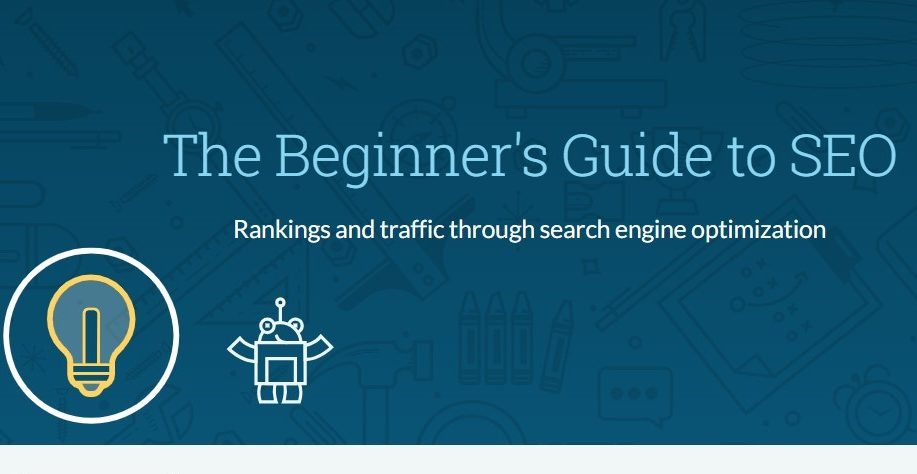
Source: Moz’s The Beginner’s Guide to SEO
Style: Professional and clear
Approach: The primary goal is to convey essential business information concisely. The tone should be welcoming, with a focus on clarity and straightforwardness. Key value propositions should be front and center.
White papers and industry knowledge
White papers provide in-depth insights on specific topics and require thorough research and a clear structure.
They start by presenting a problem or challenge relevant to an industry, follow with evidence-based solutions, and conclude with actionable takeaways or recommendations. White papers often cater to a more knowledgeable audience and can establish your brand as a thought leader, so detail is essential.

Source: Buffer’s State Of Remote Work 2023 white paper
Style: Detailed and authoritative
Approach: White papers are research-intensive and aim to educate about complex topics. The writing should establish expertise using data, studies, and expert quotes. The format should be formal and structured.
Video scripts
Video is a dynamic medium, and your script should reflect that. It needs to be engaging and direct. Plan for clear visuals and confirm that the script complements them. Transitions between topics should be smooth, and the entirety of the content should come across as cohesive. Whether you’ve hired a freelance writer or are dealing with marketing agencies, make sure the results you get are always snappy.

Source: Wistia on making videos simple
Style: Engaging and direct
Approach: Given the visual nature of videos, scripts should align closely with visual elements. The language should be snappy and to the point, guiding viewers while leaving room for visual storytelling.
Case studies
Case studies highlight real-world applications of your products or services. They start with a client’s problem, detail the solutions provided, and conclude with the results achieved. This tripartite structure—problem, solution, result—offers readers a straightforward narrative to follow.

Source: Mailchimp’s case study on how a small shoe company increased its customer base through targeted emails
Style: Narrative and solution-focused
Approach: Case studies tell a story of problem resolution. Begin with the client’s challenge, detail the solution, and conclude with the results. The tone should be factual but compelling, emphasizing positive outcomes.
Email newsletters
Newsletters keep your audience updated. They should be concise and to the point. Use engaging headlines, provide value through content, and always include clear calls to action. Given their periodic nature, make sure all email campaigns are timely and relevant.

Source: Litmus’ review of Asana’s email marketing
Style: Direct and engaging
Approach: Given the clutter in most inboxes, newsletters should grab attention instantly. Use catchy subject lines, concise content blocks, and straightforward calls to action. Personalization, where possible, can boost engagement.
Research reports
These are comprehensive documents detailing studies or surveys. They require a clear methodology, objective presentation of data, and reasoned conclusions. Graphs, charts, infographics, or even a comprehensive list can be invaluable here, helping break down complex data points for readers. And as a bonus, once you perfect this method, these lessons can even be applied to your business’ internal documentation.
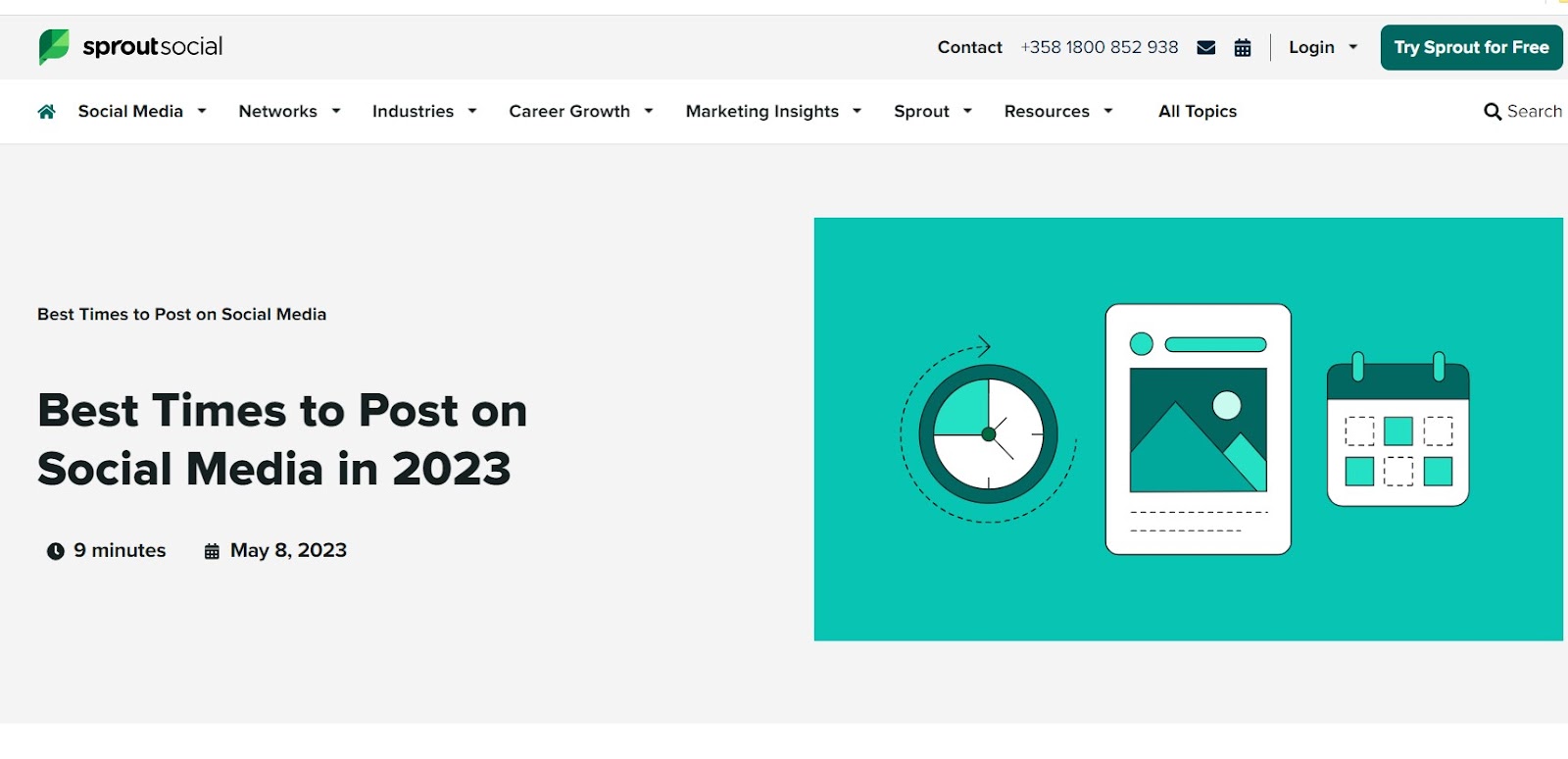
Source: Sprout Social’s Best Times to Post on Social Media in 2023 report
Style: Academic and thorough
Approach: Research reports present findings. Start with a methodology, present data logically, and end with summaries. Charts, graphs, and infographics enhance readability. The tone is neutral, focusing on facts.
Product descriptions
Effective product descriptions are clear and highlight important features and benefits. They should cater to a prospective buyer’s desires and deflect potential worries before they arrive. Always be factual, and avoid hyperbolic language.

Source: Basecamp’s About page
Style: Informative marketing with a persuasive undertone
Approach: The goal is to inform and persuade potential buyers while supplying them with the most pertinent information in the form of sales copy. Always address possible objections or questions within the description when you sell products.
Social media content
Social media is where businesses can engage directly with their audiences. Content here should be engaging and punchy and encourage interaction. Visual elements, whether images or videos, play a significant role, and the text accompanying them should be to the point and captivating.
Marketing managers and freelance writers, take note: Social media has enormous potential in building a loyal following of potential customers. It’s also a channel that only takes a little money to build, so the cost-benefit can be well worth it.

Source: Trello’s X account, which shares productivity tips, user feedback, and product updates
Style: Casual and interactive
Approach: Social media is about connection. Posts should prompt and boost engagement, whether sharing, commenting, or clicking a link. Ensure your visuals are attention-grabbing, and stop the scroll.
Guidelines for effective B2B writing
Stepping into the world of B2B writing feels different from penning content for general readers. Here are some guidelines to consider:
Prioritize brand tone of voice
Your brand’s voice sets the stage. Your distinct personality, makes you recognizable even in a crowded room. B2B content should echo this voice consistently to build relationships that last.
Whether professional, approachable, or authoritative, a brand voice offers a sense of familiarity to your audience. For example, a tech business might adopt a confident, forward-thinking tone, while an organic food wholesaler could lean into a friendly, earthy voice.
Don’t shy away from humor
Who said B2B has to be boring? Despite there being lots of lively copy out there, there’s a common misconception that your business content should be strictly formal 100% of the time. Sprinkling the occasional touch of light humor can make your content marketing more relatable and engaging. It humanizes your brand, making those business-to-business interactions feel more like person-to-person conversations.
Craft compelling subheadings and titles
Subheadings and titles are the gateway to your content and should address the reader’s core need or problem. Make them specific and pinpoint a particular job the reader wants to accomplish.
Adopt proven frameworks
Specific writing frameworks, like PAS (Problem, Agitate, Solution) or AIDA (Attention, Interest, Desire, Action), have stood the test of time. They work because they mirror the reader’s journey. In your structure, start with recognizing a problem (like slow sales) and culminate with a solution (such as a new sales strategy) to guide readers smoothly through content.
Choose clarity over cleverness
It’s tempting to weave intricate prose, but when it comes to B2B sales, clarity trumps all. Your readers are seeking answers, not riddles. Keep sentences straightforward and offer direct, actionable tips. Instead of saying, “Consider revisiting the drawing board for strategy,” guide them with, “Review your sales strategy every quarter, and adjust based on results.”
B2B writing: where quality meets scale
B2B content is all about connection, expertise, and communication.
Whether it’s a blog post sparking curiosity or a detailed white paper providing solutions, the goal remains the same: Deliver value to the reader. Conducting proper research, understanding the audience, and adapting the writing style to the content type are all pivotal steps in this journey.
Still, achieving standout B2B content can be challenging, especially with the demands of scaling. That’s where hybrid content writing comes in. Imagine getting high-quality content consistently, coupled with the insights of subject matter experts—that’s the best of both worlds.
To reach your audience effectively and leave a lasting impression, sign up for Wordbrew’s hybrid content writing services. Let’s write the future together.
